Watch the October 12 webinar recording.
Register here for the November 9 Southeast Monthly Climate Webinar, including a presentation on "Getting a Feel for Your Community's Climate Future."
Key Points
- Tropical Activity: We are past the historically most active period for the tropical storm season in the Atlantic. Fortunately, there were few direct or indirect impacts from recent activity in the region. The 2021 Atlantic hurricane season ends on November 30.
- ENSO Status: A La Niña Watch is currently in effect, and a transition from ENSO-neutral conditions to La Niña is favored in the next couple of months, with a 70%–80% chance of La Niña in the Northern Hemisphere during the winter season of 2021–22. The next update is on October 14. This may lead to warmer and drier conditions going into the winter. More information can be found here.
- Drought: Abnormally Dry (D0) conditions exist in Virginia, North Carolina, and South Carolina, with Moderate Drought (D1) in the U.S. Caribbean (Puerto Rico, parts of the Virgin Islands). Drought may continue to persist in Puerto Rico.
- Water Resources and Flooding: Streamflows remain above normal across parts of Mississippi, Alabama, Georgia, and north Florida. Reservoirs across the Southeast are near target pools, and some are heading to winter pools for the early autumn. Water resources remain adequate across the Southeast. River flood potential has a heightened risk across western sections of the region due to current above-normal streamflow conditions.
- Agriculture Impacts: Recent dry conditions have allowed fieldwork and harvest to continue apace, but wet conditions from an upper-level low have made the soil very muddy. Dry areas are still present in central and western North Carolina and Virginia but have been reduced.
Current U.S. Drought Monitor map for the Southeast, as of October 5, 2021. The U.S. Drought Monitor (USDM) is updated each Thursday to show the location and intensity of drought across the country. Drought categories show experts’ assessments of conditions related to dryness and drought including observations of how much water is available in streams, lakes, and soils compared to usual for the same time of year.
Current U.S. Drought Monitor map for Puerto Rico, as of October 5, 2021. The U.S. Drought Monitor (USDM) is updated each Thursday to show the location and intensity of drought across the country. Drought categories show experts’ assessments of conditions related to dryness and drought including observations of how much water is available in streams, lakes, and soils compared to usual for the same time of year.
Current U.S. Drought Monitor map for the U.S. Virgin Islands, as of October 5, 2021. The U.S. Drought Monitor (USDM) is updated each Thursday to show the location and intensity of drought across the country. Drought categories show experts’ assessments of conditions related to dryness and drought including observations of how much water is available in streams, lakes, and soils compared to usual for the same time of year.
U.S. Drought Monitor Categories
Current U.S. Drought Monitor map for the Southeast, as of October 5, 2021. The U.S. Drought Monitor (USDM) is updated each Thursday to show the location and intensity of drought across the country. Drought categories show experts’ assessments of conditions related to dryness and drought including observations of how much water is available in streams, lakes, and soils compared to usual for the same time of year.
Current U.S. Drought Monitor map for Puerto Rico, as of October 5, 2021. The U.S. Drought Monitor (USDM) is updated each Thursday to show the location and intensity of drought across the country. Drought categories show experts’ assessments of conditions related to dryness and drought including observations of how much water is available in streams, lakes, and soils compared to usual for the same time of year.
Current U.S. Drought Monitor map for the U.S. Virgin Islands, as of October 5, 2021. The U.S. Drought Monitor (USDM) is updated each Thursday to show the location and intensity of drought across the country. Drought categories show experts’ assessments of conditions related to dryness and drought including observations of how much water is available in streams, lakes, and soils compared to usual for the same time of year.
Climate Conditions
- Last Month’s Temperatures: Above average for Virginia, North Carolina, and Puerto Rico, and near average for the rest of the Southeast region.
- Last Month’s Precipitation: Pockets of above-average and below-average precipitation for eastern Virginia, the Carolinas, and Puerto Rico.
- Recent Tropical Weather in the Atlantic included Tropical Storms (Odette, Peter, Rose, Victor), Subtropical Storms (Teresa), and Hurricanes (Sam).
- La Niña Watch: A transition from ENSO-neutral conditions to La Niña is favored in the next couple of months, with a 70%–80% chance of La Niña in the Northern Hemisphere during the winter season of 2021–22. The next update is Thursday, October 14.
Southeast Temperature: September 10–October 9
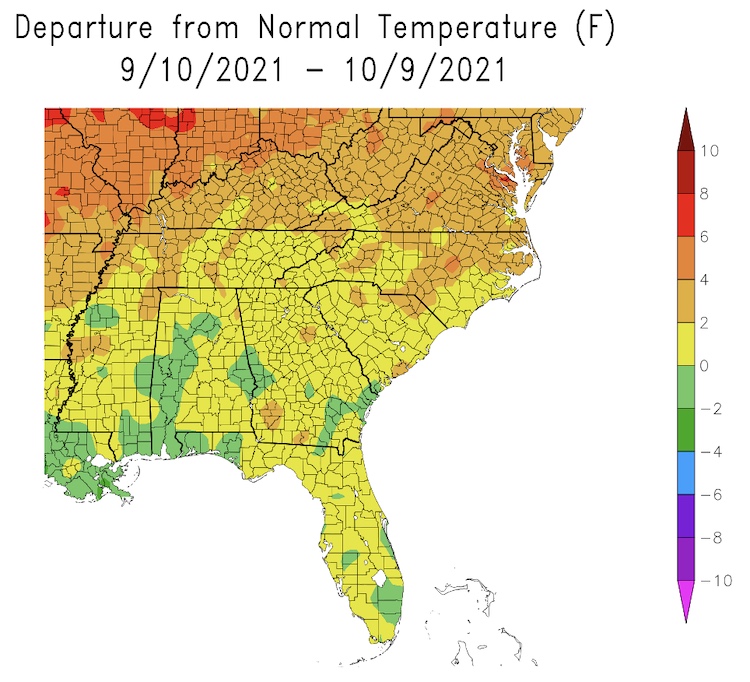
Southeast Precipitation: September 2021
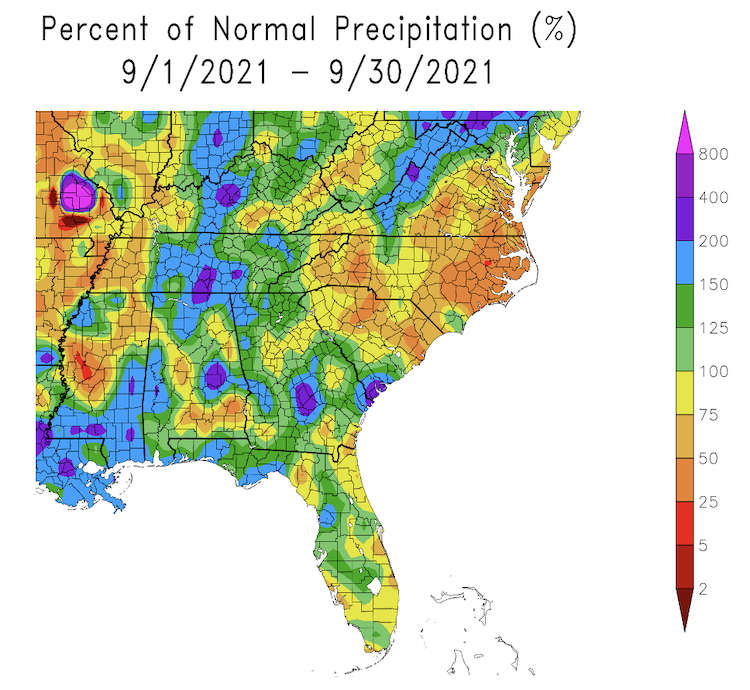
Drought
- Abnormally Dry (D0) conditions are present in Virginia, North Carolina, South Carolina, and Puerto Rico, with Moderate Drought (D1) in southern Puerto Rico and the Virgin Islands.
- Looking Ahead: Drought removal is likely; however, drought may persist in Puerto Rico.
Water Resources and Flooding
- Above-normal streamflows continue across parts of Mississippi, Alabama, Georgia, and northern Florida, with normal streamflows elsewhere.
- Reservoirs across the Southeast are near target pools, and some are heading to winter pools for the early autumn.
- Water resources remain adequate across the Southeast.
- Looking Ahead: River flood potential has a heightened risk across western sections of the region due to current above-normal streamflow conditions.
Current Conditions: River Flood Status
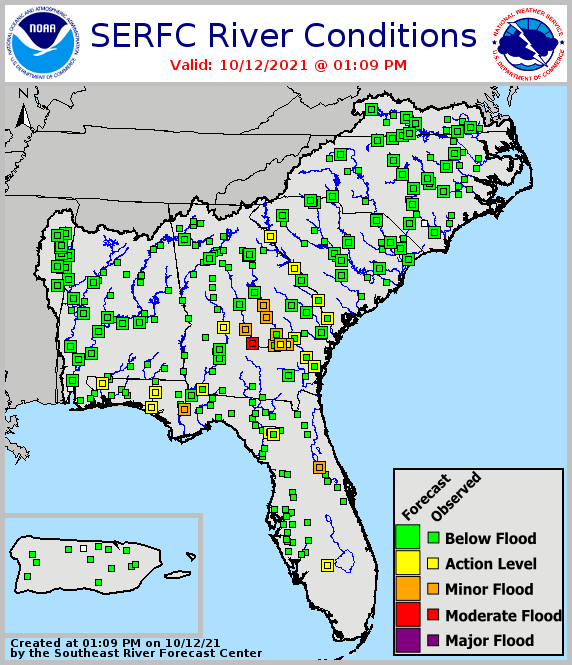
Looking Ahead: October–December Flood Outlook
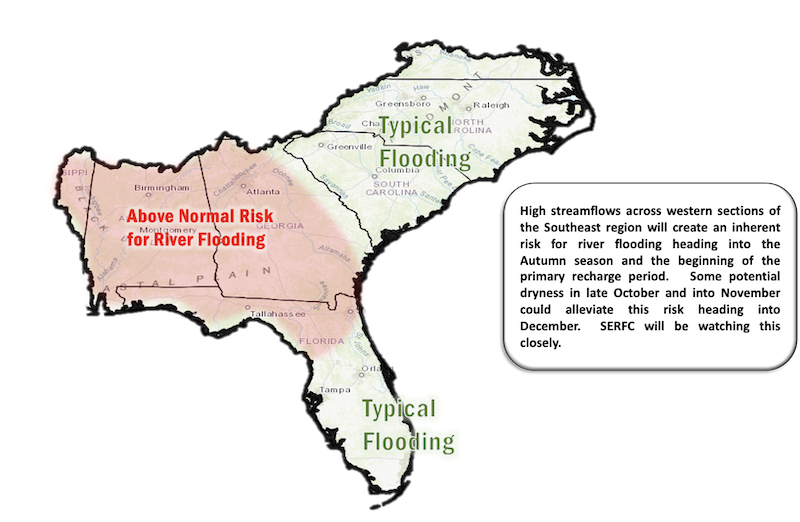
Agriculture Impact and Outlook
- Dry weeks have allowed fieldwork and harvest to continue apace, but wet conditions from an upper-level low have made the soil very muddy.
- Dry areas in central and western North Carolina and Virginia are still there but reduced.
- Thee has been lots of disease pressure from fungal diseases, less from insect pests.
- Looking Ahead: Farmers will have to time their work around dry periods. The tropics are currently quiet, but the season has not ended yet.
Looking Ahead: Climate Outlooks
- October 16–20 Outlook: Odds favor warmer temperatures across the Southeast, with a probability of drier conditions except in southern Florida.
- Next Three Months: October–December will likely be warm, with equal chances of wetter or drier conditions in Virginia and North Carolina and the probability of drier conditions elsewhere.
Temperature Outlook: October–December 2021
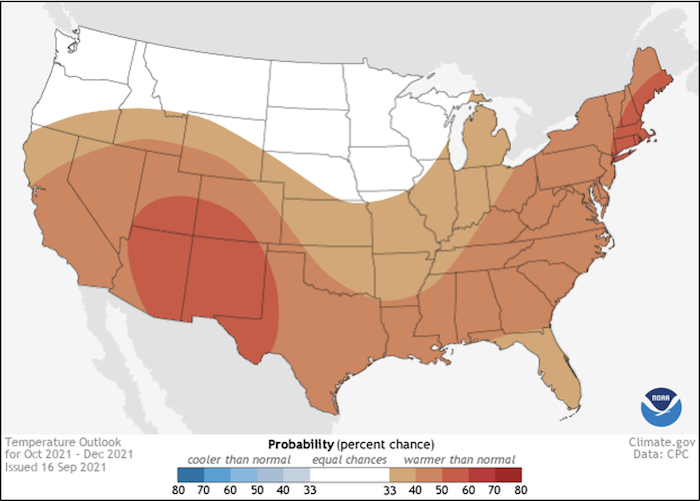
Precipitation Outlook: October–December 2021
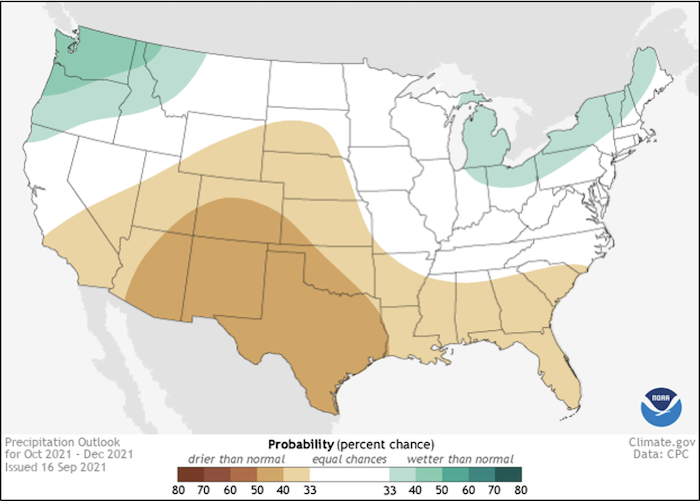
Report Prepared By
- Sandra Rayne, Southeast Regional Climate Center
- Todd Hamill, National Weather Service Southeast River Forecast Center
- Pam Knox, University of Georgia
- Meredith Muth, NOAA National Integrated Drought Information System
Additional Resources
Regional Products
- Southeast Regional Climate Center (SERCC)
- SERCC Southeast Region Monthly Climate Reports
- National Weather Service Southeast River Forecast Center (SERFC)
- U.S. Geological Survey Streamflow Monitoring & Forecasting
- National Weather Service Climate Prediction Center: Outlook Products
- ACIS Climate Maps, High Plains Regional Climate Center
- NOAA El Niño/Southern Oscillation (ENSO) Blog
- Climate and Agriculture in the Southeast: Blog
Hurricane Preparedness
- National Hurricane Center
- Graphical Tropical Weather Outlook
- National Hurricane Preparedness Week
- National Hurricane Center Facebook page
- National Hurricane Center Twitter page
- USDA Hurricane Preparation and Recovery Guides
State Climate Offices
The Southeast Climate monthly webinar series is held on the second Tuesday of each month at 10:00 a.m. ET. This series is hosted by the Southeast Regional Climate Center, in partnership with the National Integrated Drought Information System (NIDIS) and the NOAA National Weather Service. These webinars provide the region with timely information on current and developing climate conditions such as drought, floods and tropical storms, as well as climatic events like El Niño and La Niña. Speakers may also discuss the impacts of these conditions on topics such as agriculture production, water resources, wildfires and ecosystems.
For webinar-related questions or suggestions, please contact Meredith Muth (meredith.f.muth@noaa.gov).




